Nature’s kaleidoscope of botanical wonders never ceases to amaze us, and within its vast collection lies a peculiar group of plants that possess a peculiar trait; they all bear names that commence with the letter Q. Join us on an enchanting journey through this rare assemblage as we unveil 20 captivating plants that start with the enigmatic letter Q!
1. Quinoa
Classification: Chenopodium quinoa
The first entry on our list of plants that start with Q is the ever-recognizable quinoa! Quinoa is a very nutrient-dense seed that resembles grains and has grown in popularity in recent years. Despite frequently being called a grain, it is a seed. When cooked, quinoa has a delicate, fluffy texture and a mild, nutty taste. It comes in a variety of shades, including brown, white, red, and black, each having a slightly different flavor and texture.
Quinoa grows in the high-altitude regions of nations like Peru, Bolivia, and Ecuador. It was first grown in the Andean region of South America. These hardy plants can resist challenging circumstances, such as freezing temperatures and poor soil conditions. For millennia, indigenous peoples of the Andes relied on quinoa as a primary food source, and it is still a major crop in these regions.
Quinoa has a remarkable nutritional profile, which is one of its most noticeable advantages. It is a complete protein source since it is high in protein and contains all nine necessary amino acids. Just as well, dietary fiber, vitamins, and minerals including magnesium, iron, and phosphorus are all abundant in quinoa. It is also gluten-free, making it a great substitute for those who have celiac disease or gluten sensitivity.
Quinoa also has several health advantages. It is linked to better heart health, weight control, and digestion. Its high fiber content aids in maintaining regular bowel motions and good digestion. Quinoa’s complex carbs slowly release energy, helping with weight management and supplying long-lasting energy. Just as well, by lowering the risk of cardiovascular disorders, the magnesium and antioxidants in quinoa enhance heart health.
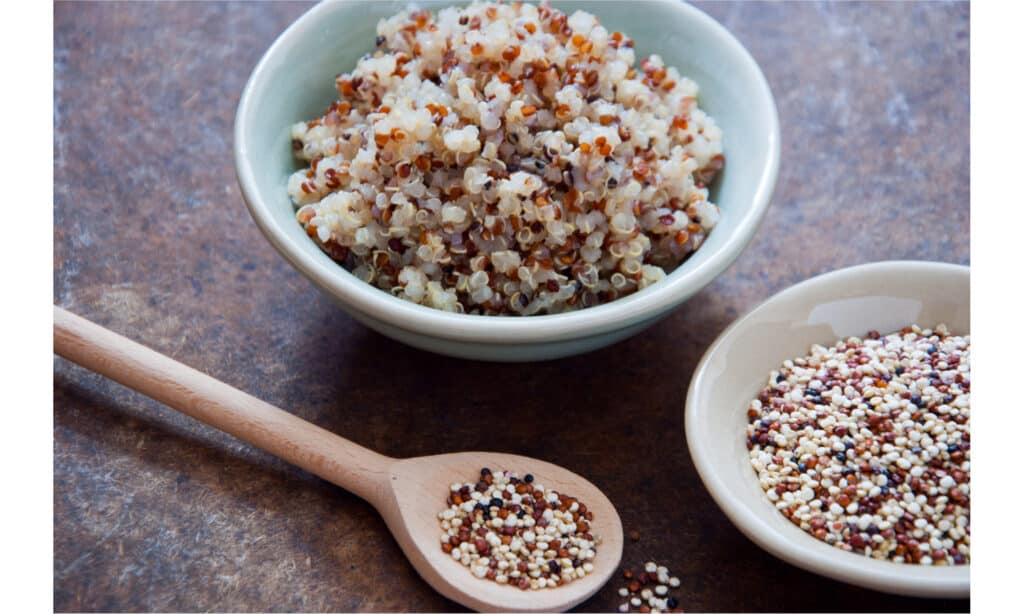
Quinoa has become a popular staple ingredient in health-food dishes around the world.
©iStock.com/letterberry
2. Quince
Classification: Cydonia oblonga
The Rosaceae family includes the fruit-bearing tree known as the quince. This plant that starts with Q is well-known for its fragrant, golden-yellow fruit that has a characteristic pear-like form. Since ancient times, quince trees have been farmed in the Caucasus area of Central Asia. They are now cultivated throughout the world, especially in Asia, Europe, and North America.
Due to its astringent and acidic flavor, quince fruit is rarely eaten uncooked. It may, however, be turned into scrumptious preserves, jams, and jellies. Quince is rich in antioxidants, vitamin C, and dietary fiber. The fiber in the apple helps assist a healthy digestive system and control blood sugar levels. Quince also has advantageous phytonutrients and antioxidants that improve general health and overall well-being.
Quince has been utilized in traditional medicine for its possible health advantages in addition to its nutritional content. It has anti-inflammatory qualities and might improve digestion, heart health, and immunological function. Pectin, a natural fiber that helps decrease cholesterol levels, is another component of quince that is abundant in its fruit.

Quince trees are as small as bonsai trees. However, their fruits usually stay close to normal size, which can make them too heavy for bonsais.
©khuntapol/Shutterstock.com
3. Quassia
Classification: Quassia amara
A tropical tree species called quassia is well-known for its therapeutic qualities. South American nations including Brazil, Suriname, and Guyana are home to this plant, which is endemic to the South American continent. Because of its digestive and insecticidal qualities, quassia has a long history of usage in herbal therapy.
Quassin, a powerful chemical found in the bark and wood of the quassia tree, is what gives it its medicinal properties. Quassin possesses antiparasitic, antimalarial, and antipyretic effects. Intestinal conditions including indigestion, bloating, and cramping have all been treated with it. Quassia effectively combat parasites including intestinal worms and lice.
Quassia has also been used as a natural pesticide. Quassin works as an efficient pest deterrent against a variety of pests, including aphids, mites, and leafhoppers, due to its poisonous nature and bitter flavor. In organic farming, it is frequently used to safeguard crops from pest damage.
Take quassia with caution because excessive use might have negative effects. Before using quassia products, anyone who is pregnant, has liver issues or is taking certain drugs should talk to their doctor.
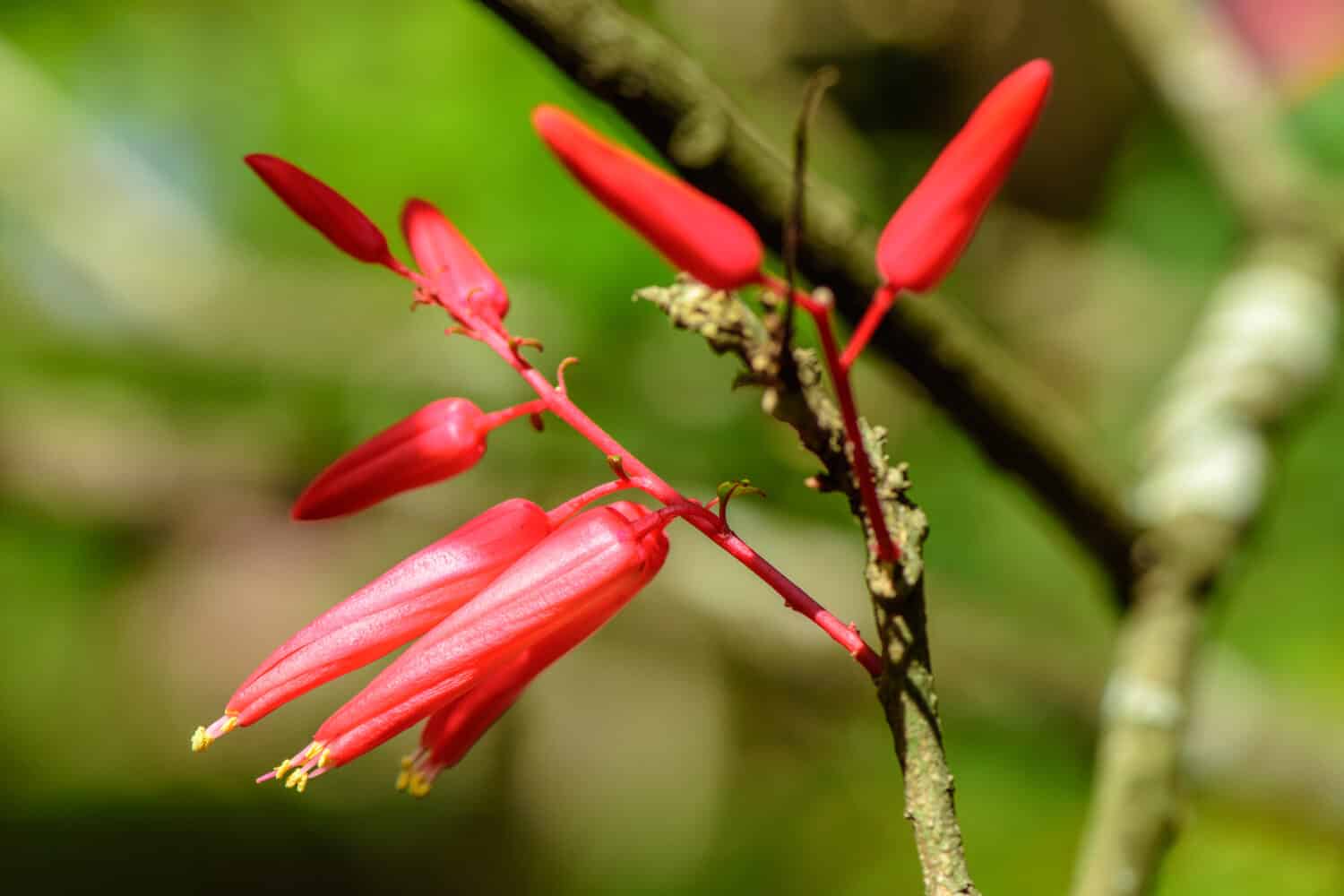
Quassia trees boast flowers with bright red petals, which put on a show when they are in bloom!
©pisitpong2017/Shutterstock.com
4. Quinine Tree
Classification: Cinchona spp.
Another indigenous species of blooming evergreen tree native to South America’s tropical areas is the quinine tree. It is especially well-known for its therapeutic benefits and the creation of quinine, a naturally occurring chemical obtained from its bark.
Since ancient times, quinine is in use to treat malaria. Quinine and other alkaloids found in the tree’s bark have antimalarial qualities. This alkaloid works by preventing the malaria parasite’s development and reproduction, which helps to reduce symptoms and stop the disease from spreading.
Quinine trees grow best in cold, high-altitude regions with rich, well-drained soils. They may frequently be found in places like Bolivia, Peru, Ecuador, and Colombia. Quinine trees have also been cultivated in other regions of the world because of their substantial medicinal potential.
In addition to its effectiveness against malaria, quinine is also in use to treat other ailments including fever and leg cramps. It has also been used for a very long time to flavor tonic water, giving it a very bitter flavor.
Quinine may have adverse effects and interact with some drugs, so it’s crucial to get medical advice before utilizing quinine-based medicines for therapeutic purposes.
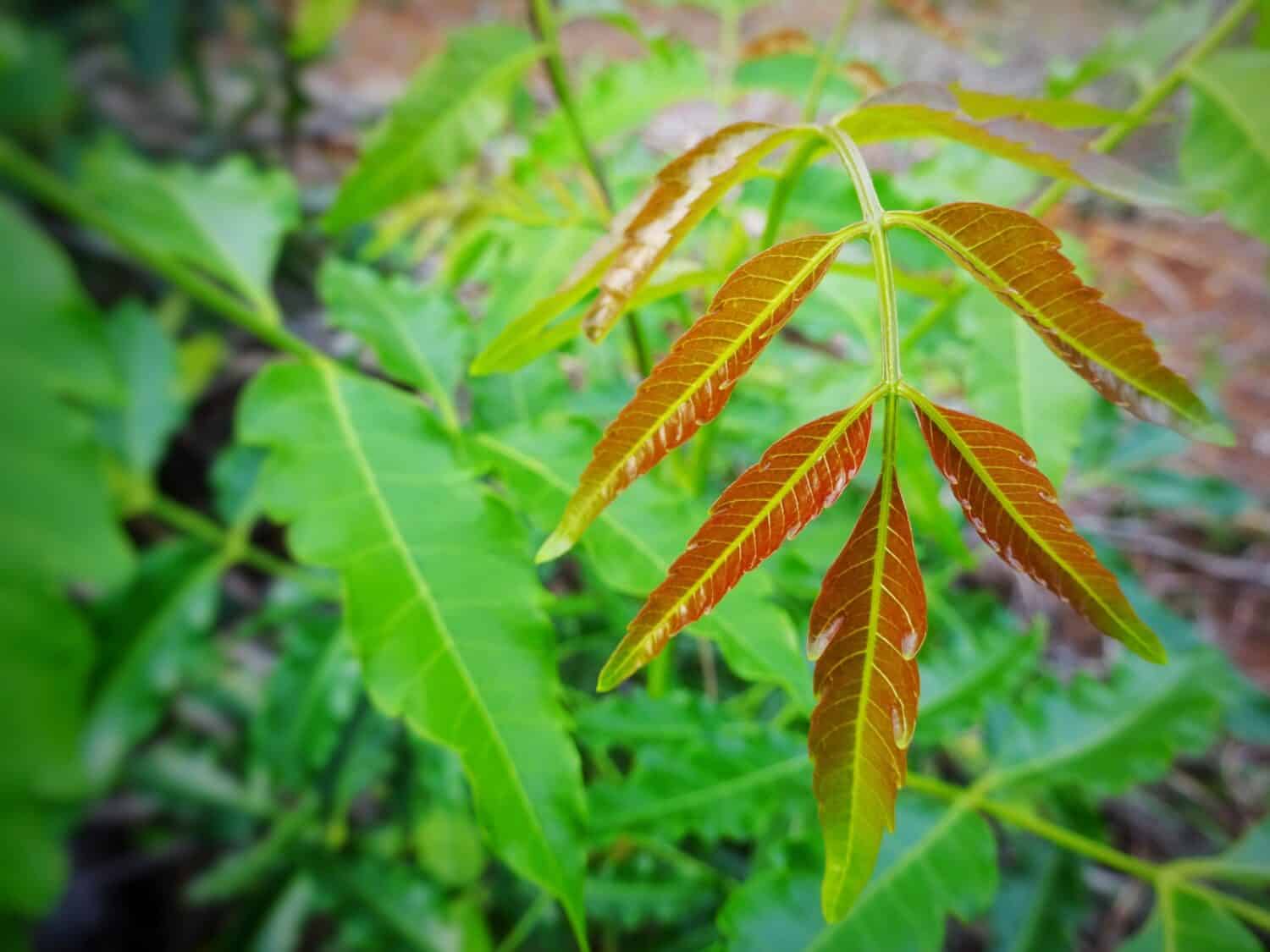
Quinine trees are known for their beautiful foliage and medicinal properties, particularly in defense against malaria.
©Natural Mosart/Shutterstock.com
5. Quercus
Classification: Quercus spp.
Quercus is a group of plants best known as oaks. This broad genus, with over 500 species, grows in a wide range of environments around the world, from the cold regions of the Northern Hemisphere to tropical Asia and the Americas. Many species possess a formidable size and long lifespan, establishing a prominent presence in forests and landscapes.
Oaks are a source of food and habitat for many creatures; their acorns provide nourishment for numerous bird and mammal species. People also value oaks for their utility and beauty. The timber, which is notably hard and strong, is commonly in use for construction, furniture, and barrel-making. Just as well, oaks have deep cultural and symbolic significance in many societies, often symbolizing strength and endurance. As such, these trees are much more than just part of the scenery; they are essential players in ecological, economic, and cultural narratives.

Quercus or oak trees come in many species, shapes, colors, heights, and overall appearance.
©Radka Palenikova/Shutterstock.com
6. Queen Anne’s Lace
Classification: Daucus carota
Queen Anne’s Lace is a wildflower with a delicate, lacy appearance. Its name draws from a legend of Queen Anne of England pricking her finger and a drop of blood landing on the lace she was sewing, symbolized by a dark purple floret found in the plant’s center. This hardy perennial usually sports umbrella-like clusters of tiny white flowers atop tall stems, creating an effect reminiscent of an antique lace doily.
This wildflower grows in various parts of the world. It favors dry, sunny locations, and is commonly in fields, along roadsides, and in waste places. It is extremely adaptive and can thrive in a variety of soils, including poor, rocky, or sandy soils.
Queen Anne’s Lace is more than a charming wildflower; it has various practical uses as well. The plant’s root, similar to a carrot, is edible when young. Its flowers can be used to make a soothing tea. In traditional medicine, it has been employed for its diuretic, antiseptic, and carminative properties. As a pioneer plant, it also helps enrich and stabilize the soil, benefiting other plants in its vicinity.

Queen Anne’s lace is a popular flower to use in floral arrangements due to the tiny, delicate, white flowers it produces.
©Antho B/Shutterstock.com
7. Queen’s Wreath
Classification: Petrea volubilis
A stunning, fast-growing tropical vine known for its vine-like clusters of lavender or mauve blooms is called the queen’s wreath plant. These exquisite blooms, which are shaped like stars and bloom all year long under the right circumstances, give the plant its royal name by giving the appearance of a sumptuous wreath befitting a queen.
The queen’s wreath, a plant native to Central America and the Caribbean, thrives in hot conditions but can also withstand moderate cold, making it adaptable to many environments. With grace and vitality, this sun-loving plant twines and climbs around fences, arbors, and trees in well-drained soil.
The queen’s wreath not only adds beauty to any garden but also gives many animals a home and a source of food. It’s a great plant for a pollinator garden because of the hummingbirds, butterflies, and bees brought to its blossoms. Its minimal care requirements and resistance to most pests and diseases make it a popular choice for gardeners. The queen’s wreath serves as a monument to arid nature’s regal majesty by being both visually beautiful and environmentally friendly.

Queen’s wreath is a popular flower garden selection in hot climates such as Arizona because of its incredible heat tolerance.
©Doikanoy/Shutterstock.com
8. Queensland Nut
Classification: Macadamia integrifolia
The Queensland nut, or the macadamia, is a name that brings to mind images of tasty, creamy nuts often used in cookies, candies, and health foods. This plant that starts with Q comes from the rainforests of eastern Australia, specifically in the state of Queensland. These evergreen trees grow in various tropical and subtropical regions worldwide, including Hawaii, California, and South Africa, due to their highly sought-after nuts.
The macadamia tree is an asset to both the environment and humans. It’s a robust plant that helps stabilize the soil with its deep roots and contributes to biodiversity by providing a habitat for various bird and insect species. The star attraction, however, is undoubtedly its nuts. Enclosed in a hard, woody shell, Queensland nuts are a treasure trove of nutrients. They are rich in monounsaturated fats, which are heart-healthy and are a good source of vitamins, minerals, and antioxidants. So, whether for its environmental benefits or its nutritious nuts, the Queensland nut tree is indeed a gem of nature!

Queensland nuts are very tasty and often used in baking, but are very beneficial in terms of antioxidants and vitamins.
©Wichadarom Rongsriyaem/Shutterstock.com
9. Queen of the Night Cactus
Classification: Epiphyllum oxypetalum
The Queen of the Night cactus is a beautiful plant that starts with Q with a special place in the world of botany. This South and Central American native leafless cactus is prized for its eye-catching nighttime flowers. Only after dusk and before dawn do the plant’s enormous, fragrant, moonlight-white blossoms open, giving it its regal and enigmatic name.
This intriguing cactus is commonly climbing trees as an epiphyte in its natural environments. It grows well in well-draining soil and warm, tropical temperatures. It is popular among desert gardeners since it is easy to maintain and tolerant of a range of environments.
However, the Queen of the Night is more than simply a garden spectacle. Due to its transitory blossoms, it is frequently connected with love and longing and has considerable cultural importance in many countries. In addition to being physically appealing, its blossoms have a seductive, sweet aroma that draws pollinators and promotes biodiversity.
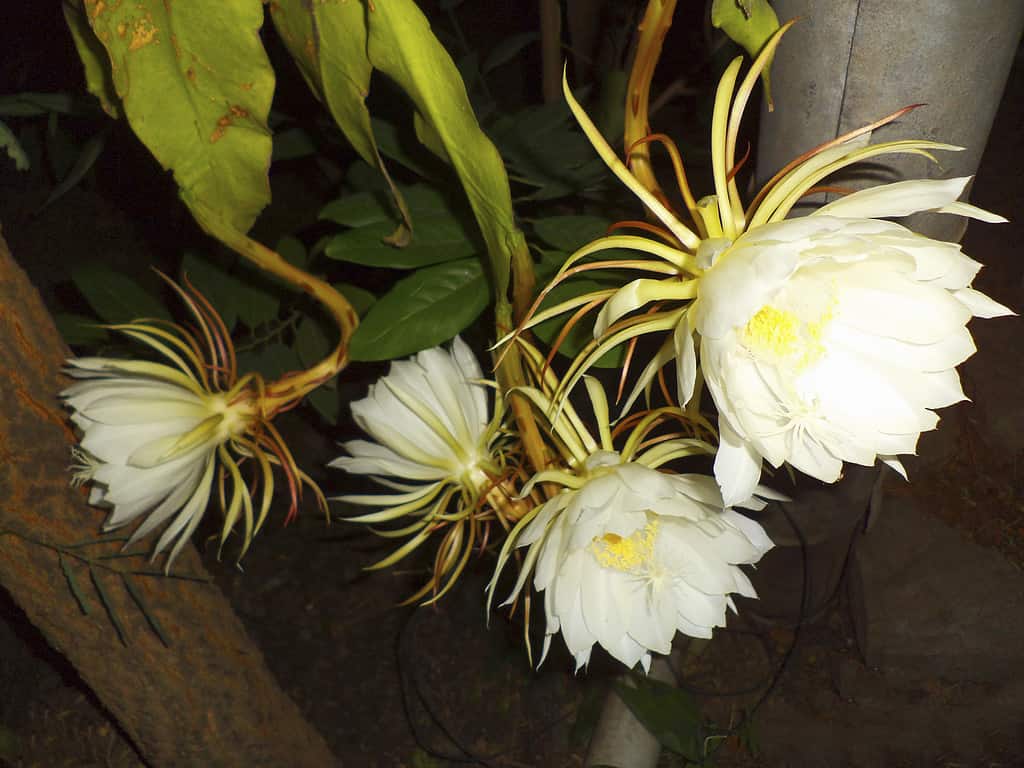
The Queen of the Night cactus is unique in that its flowers only bloom at night.
©iStock.com/ePhotocorp
10. Quaking Aspen
Classification: Populus tremuloides
The last entry on our list of plants that start with Q is the quaking aspen. Quaking aspen is a striking deciduous tree, aptly named for the fluttering motion its leaves make even in the gentlest breeze. This intriguing phenomenon, created by the tree’s flattened leaf stalks, results in a peaceful rustling sound and a shimmering appearance, painting a vivid picture of a serene forest landscape.
Renowned for being one of the most widely distributed trees in North America, the quaking aspen thrives from Alaska to Mexico, spanning both coasts. It can grow at various elevations and prefers well-drained soils, making it highly adaptable to different environments.
The quaking aspen is also a very special beneficial tree species. As a pioneer species, it plays a vital role in forest recovery after disturbances like fires or logging, rapidly growing and enriching the soil for other plants. Its bark, leaves, and buds provide sustenance for various wildlife species, including deer, moose, and numerous birds. Additionally, the tree is useful to humans for its lightweight yet sturdy wood, which is used in products like paper, matchsticks, and crates. Ecologically beneficial and aesthetically pleasing, the quaking aspen is a remarkable part of our natural landscapes.
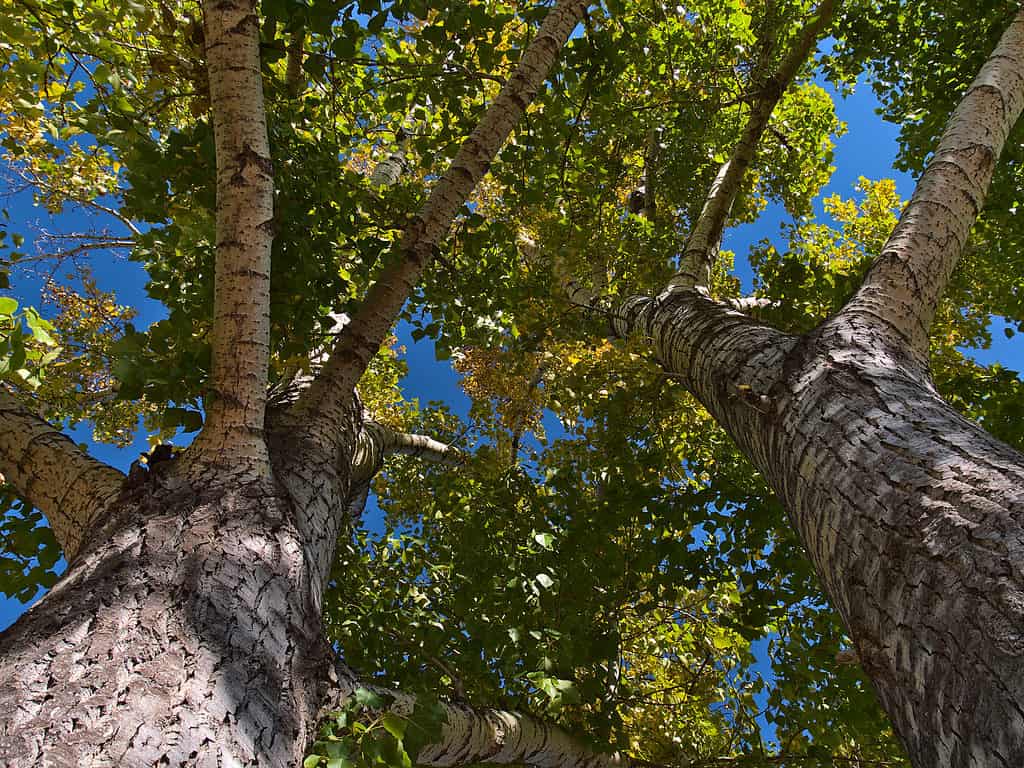
Quaking aspen is a beneficial pioneer tree species that can aid in forest recovery after wildfires.
©iStock.com/Timon Schneider
More Plants That Start With Q
| # | Plant | Classification |
|---|---|---|
| 1 | Quinoa | Chenopodium quinoa |
| 2 | Quince | Cydonia oblonga |
| 3 | Quassia | Quassia amara |
| 4 | Quinine Tree | Cinchona spp. |
| 5 | Quercus | Quercus spp. |
| 6 | Queen Anne’s Lace | Daucus carota |
| 7 | Queen’s Wreath | Petrea volubilis |
| 8 | Queensland Nut | Macadamia integrifolia |
| 9 | Queen of the Night Cactus | Epiphyllum oxypetalum |
| 10 | Quaking Aspen | Populus tremuloides |
| 11 | Quadricolor Century Plant | Agave lopthana ‘Quadricolour’ |
| 12 | Quaker’s Bonnet | Primula vulgaris ‘Lilacina Plena’ |
| 13 | Quaking Grass | Briza media |
| 14 | Queen Anne’s Pocket Melon | Cucumis melo dudaim |
| 15 | Queen Antherium | Anthurium warocqueanum |
| 16 | Quilegia | Aquilegia spp. |
| 17 | Queen Victoria Agave | Agave victoriae-reginae |
| 18 | Quamash | Camassia spp. |
| 19 | Quandong Fruit | Santalum acuminatum |
| 20 | Quinalt Strawberries | Fragaria × ananassa ‘Quinault’ |
Thank you for reading! Have some feedback for us? Contact the AZ Animals editorial team.








